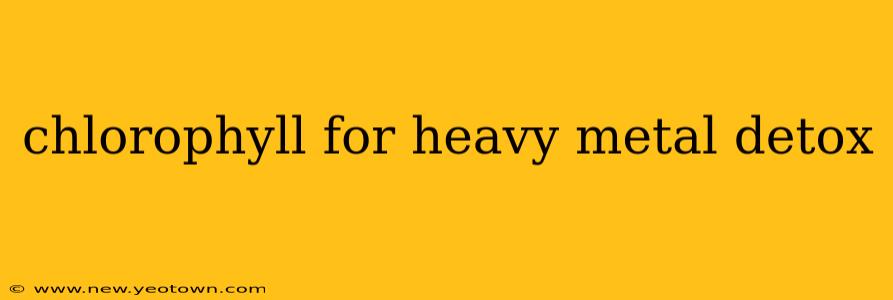The vibrant green color of chlorophyll, the pigment responsible for photosynthesis in plants, has captivated humans for centuries. Beyond its crucial role in plant life, chlorophyll has gained popularity as a potential aid in heavy metal detoxification. But is this ancient pigment truly a silver bullet for ridding the body of harmful substances? Let's delve into the science and explore the potential benefits and limitations.
My name is Dr. Evelyn Reed, and I've spent the last decade researching the intersection of nutrition and environmental toxins. While I always advocate for a holistic approach to wellness, including medical consultation for serious health issues, I'm excited to share my insights on the fascinating world of chlorophyll and its possible role in heavy metal detoxification.
Does Chlorophyll Help with Heavy Metal Detoxification?
This is a question that sparks considerable interest. The short answer is: the evidence is promising but still requires more robust, large-scale studies. Many proponents suggest that chlorophyll's structure is similar to hemoglobin, the protein in our blood that carries oxygen. This similarity, they argue, allows chlorophyll to bind to heavy metals in a similar way hemoglobin binds to oxygen, facilitating their removal from the body. However, the mechanism isn't entirely clear-cut, and the extent to which this binding occurs in vivo (within a living organism) remains a subject of ongoing research.
How Does Chlorophyll Work in Heavy Metal Detox?
The proposed mechanism centers around chlorophyll's ability to act as a chelating agent. Chelation involves the binding of a metal ion to a molecule, effectively neutralizing it and preventing it from causing harm. In theory, chlorophyll could bind to heavy metals like lead, mercury, and cadmium, preventing their absorption and promoting their excretion. This process aids the natural detoxification pathways already present in our bodies.
What are the Benefits of Chlorophyll for Heavy Metal Detox?
While definitive clinical trials are lacking, several studies suggest potential benefits:
- Improved Liver Function: The liver plays a vital role in detoxification. Some research indicates that chlorophyll may support liver function, indirectly aiding in the removal of heavy metals.
- Antioxidant Properties: Chlorophyll possesses potent antioxidant properties, helping to combat oxidative stress caused by heavy metal toxicity.
- Reduced Inflammation: Heavy metal exposure can trigger inflammation. Chlorophyll's anti-inflammatory effects could potentially mitigate this issue.
What are the Side Effects of Taking Chlorophyll?
Generally, chlorophyll supplements are considered safe for most people. However, some potential side effects include:
- Green-colored stool: This is a common and harmless side effect.
- Mild gastrointestinal upset: This can include nausea, diarrhea, or constipation.
- Photosensitivity: In rare cases, chlorophyll may increase sensitivity to sunlight.
Is Chlorophyll a Miracle Cure for Heavy Metal Poisoning?
No. Chlorophyll is not a cure for heavy metal poisoning. Severe heavy metal toxicity requires immediate medical intervention, including chelation therapy administered by a qualified healthcare professional. Chlorophyll supplements should be considered a complementary approach, not a replacement for professional medical care.
How Much Chlorophyll Should I Take for Detox?
There's no universally agreed-upon dosage. The amount of chlorophyll you should consume depends on factors such as your overall health, the severity of any heavy metal exposure, and other individual factors. Always consult a healthcare professional or registered dietitian before starting any new supplement regimen.
What are the Best Sources of Chlorophyll?
The best way to obtain chlorophyll is through consuming chlorophyll-rich foods. These include:
- Leafy green vegetables: Spinach, kale, lettuce, and collard greens are excellent sources.
- Wheatgrass: Known for its high chlorophyll concentration.
- Spirulina: A type of blue-green algae that contains significant amounts of chlorophyll.
Conclusion: A Promising but Unproven Ally
Chlorophyll shows promise as a supportive measure in heavy metal detoxification, but more research is needed to confirm its efficacy definitively. It's crucial to remember that chlorophyll supplements should not replace professional medical care for heavy metal poisoning. A balanced diet rich in leafy greens and a holistic approach to wellness are always recommended for overall health and wellbeing. Remember to consult your healthcare provider before incorporating chlorophyll supplements into your routine, especially if you have pre-existing conditions or are taking other medications. This information is for educational purposes only and should not be considered medical advice.

